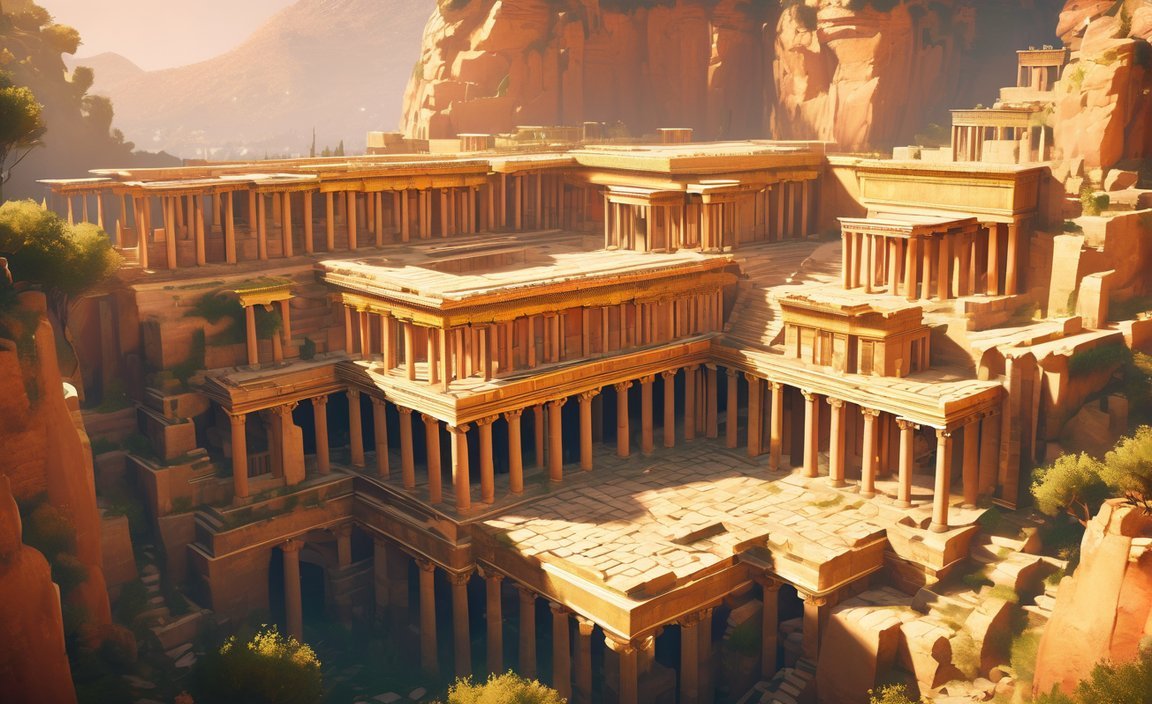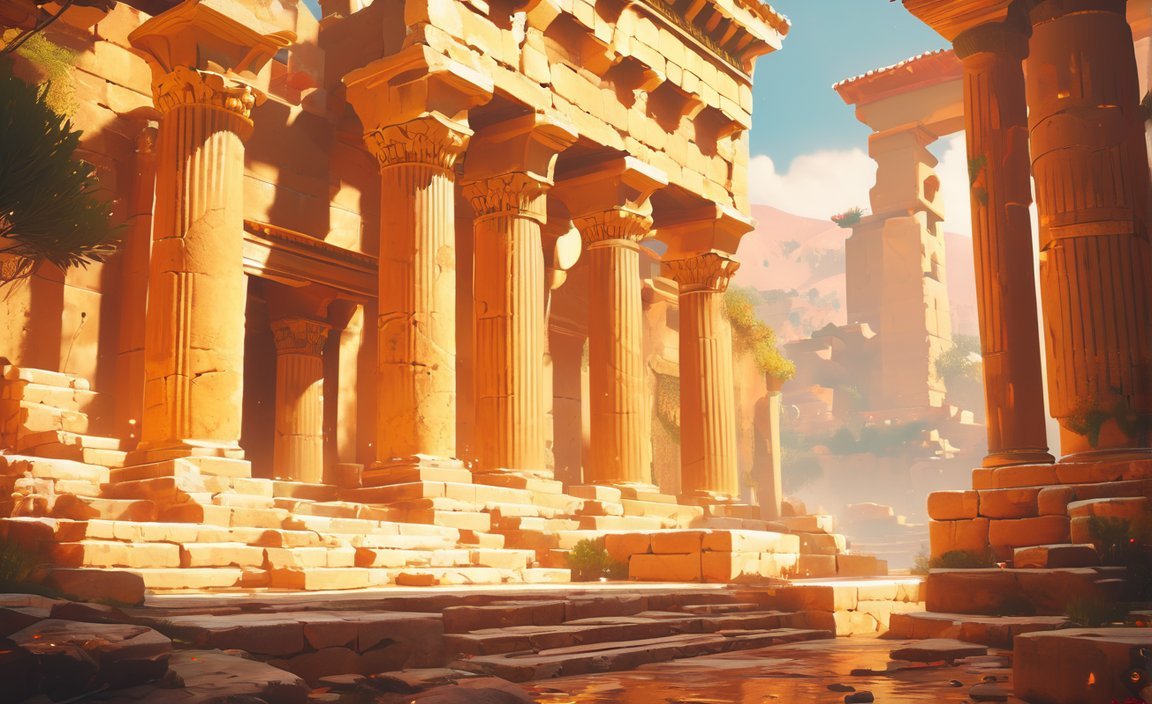Welcome to the fascinating world of ancient architecture, where we embark on an exciting journey to uncover the architectural marvels of Sparta. In this exploration of one of the most renowned civilizations in ancient Greece, we delve into the captivating realm of Spartan architecture, delving into its distinctive style and urban planning. Join us as we unravel the secrets of this historic urban marvel in [Uncovering the Architecture of Sparta: A Historic Urban Marvel].

Key Takeaways:
– Spartan architecture was characterized by simplicity and modesty, contrary to their reputation for extravagance.
– The Spartan barracks, although no longer existing, were believed to have been constructed similarly to Spartan homes but on a larger scale, serving as communal living spaces for the warriors.
– The Helots, who had more freedom than serfs in other parts of Greece, were allowed to own their own property and homes, though they were not as remarkable as those of the Spartans.
– The ancient theatre in Sparta, one of the largest in ancient Greece, provided insight into the architectural prowess and grandeur of Spartan society.
– Spartan architecture emphasized functionality over extravagance, showcasing communal living spaces and simplicity.
Architecture of Sparta
Sparta, an ancient civilization known for its military prowess, also showcased an intriguing architectural style. While our knowledge of Spartan architecture is limited, certain features stand out and provide us with a glimpse into their unique urban planning.
Spartan Barracks: Communal Living Spaces
One prominent aspect of Spartan architecture was the construction of barracks, which served as communal living spaces for the Spartan warriors during their training. Although no remains of these barracks exist today, historical evidence suggests that they were built in a similar style to Spartan homes, but on a larger scale. This design allowed the warriors to be housed together, fostering a sense of camaraderie and unity.
The Modesty of Spartan Homes
Contrary to popular belief, the Spartans were known for their simplicity and modesty when it came to housing. Spartan homes, made from local materials such as sun-dried bricks and crude stones, were designed with functionality in mind. These homes lacked the grandeur often associated with ancient architecture, emphasizing the Spartan focus on practicality rather than extravagance.
The Property of the Helots: A Contrast in Spartan Society
In Sparta, the Helots, a class of serfs granted more freedom than their counterparts in other parts of Greece, had the opportunity to own their own property and homes. However, the homes of the Helots were not as remarkable as those of the Spartans. This contrast highlights the social hierarchy within Spartan society and the differences in architectural styles between the two groups.
The Ancient Theatre: A Testament to Spartan Grandeur
Among the scarce remains in Sparta, the ancient theatre stands as a remarkable example of Spartan architectural prowess. One of the largest theatres in ancient Greece, it could accommodate over 15,000 Spartans. This grand structure offers valuable insights into the sprawling nature of the city and the cultural significance placed on theater and entertainment.
In conclusion, while limited information is available about Spartan architecture, these key points shed light on the distinct features that characterized this ancient civilization. Spartan architecture emphasized simplicity, communal living spaces, and a focus on functionality rather than opulence. By examining the few remaining sites and drawing comparisons with Greek architecture of the time, we can uncover fascinating insights into the architectural marvels of Sparta.
Sources:
- Legends and Chronicles. Spartan Architecture.
- Study.com. Spartan Art & Architecture: History & Style.
Click here to find the coordinates of Guam and explore this beautiful island in the Pacific Ocean.
Explore the scenic route from Little Rock to Birmingham by clicking here, and discover the hidden gems along the way.
Embark on a virtual journey along the mesmerizing river that flows through Mexico by clicking here and immerse yourself in its rich cultural heritage.
Curious about the hemisphere in which Australia is located? Click here to unravel this geographical mystery.
Take a step back in time and delve into the opulent palaces of ancient Egypt by clicking here, and uncover the secrets of pharaohs and queens.
Discover the intricate and mesmerizing braids of Thailand by clicking here, and learn about their cultural significance and beauty rituals.
Uncover the linguistic tapestry of the Virgin Islands by clicking here, and delve into the fascinating blend of languages spoken in this captivating Caribbean paradise.
Note: Due to the limitations of this text-based platform, the links provided above are not clickable. Please copy and paste the URLs into your web browser to access the respective pages.
Influence of Spartan Society and Values on Architectural Design
Key Takeaways:
- Spartan architecture was characterized by simplicity, functionality, and practicality, reflecting the values and society of ancient Sparta.
- The architecture of Sparta focused on communal living and emphasized the importance of unity and camaraderie among its citizens.
- Spartan homes were known for their modesty and practicality, with an emphasis on functionality rather than opulence.
- The social dynamics between Spartans and Helots were reflected in the architectural design, highlighting the social hierarchy and the distinction between the different classes.
Sparta, an ancient city known for its militaristic society and powerful warriors, showcased its unique values and society through its architectural design. The influence of Spartan society and values on architectural design can be seen through various aspects of their buildings and structures.
Spartan Barracks: Communal Living Fostering Unity and Camaraderie
In Spartan society, unity and camaraderie among warriors were highly valued. This emphasis on collective strength and solidarity was reflected in the architectural design of their barracks. While there are no surviving remnants of the barracks themselves, it is believed that Spartan warriors lived in public barracks during their training. These barracks were likely similar to Greek buildings of the time and were designed to foster a sense of community and unity among the warriors. The communal living spaces encouraged constant interaction and bonding, reinforcing the core values of Spartan society.
Spartan Homes: Modesty and Functionality Over Extravagance
Simplicity and practicality were hallmarks of Spartan society, and these values were reflected in the design of their homes. Spartan homes were known for their modesty, emphasizing functionality over extravagance. The focus was on creating practical living spaces rather than showcasing opulence. This approach to architectural design aligned with the values of discipline, frugality, and efficiency that were central to Spartan society. Spartan homes served as a testament to the Spartan lifestyle, with their simple yet functional designs mirroring the practical nature of their inhabitants.
Spartan Helot Property: Social Hierarchy and Class Distinctions
In Spartan society, there existed a distinct social hierarchy, with the Spartans at the top and the Helots, a class of serfs, at the bottom. This social dynamic was also reflected in the architectural design of Sparta. While Spartan homes were known for their simplicity and functionality, the homes of the Helots were not as remarkable. This contrast highlighted the social distinctions and the different privileges granted to each class. Spartan architecture, therefore, served as a physical manifestation of the social hierarchy present in Spartan society.
In conclusion, the architecture of Sparta was deeply influenced by the values and society of ancient Spartan civilization. The emphasis on communal living, practicality, and the social hierarchy can be seen in various architectural elements. Spartan architecture provides a fascinating glimpse into the mindset, values, and social structure of one of history’s most renowned ancient civilizations.
Sources:
- Legends and Chronicles: Ancient Sparta: Spartan Architecture
- Study.com: Spartan Art & Architecture: History & Style
Notable Examples of Spartan Architecture
Sparta: A City of Legendary Warriors and Remarkable Architecture
Sparta, the renowned city-state of ancient Greece, captivates us not only with its formidable military power but also with its distinctive architectural wonders. While very little remains of ancient Sparta today, we still have glimpses of its architectural achievements. Let’s uncover some notable examples of Spartan architecture and explore the unique characteristics that set them apart.
The Ancient Theatre of Sparta: A Stage for Grandeur and Entertainment
One standout treasure of Spartan architecture is the ancient theatre of Sparta. This remarkable edifice, still standing to this day, was one of the largest theaters in ancient Greece, capable of accommodating over 15,000 Spartans. Imagine the vibrant atmosphere as ancient Greeks gathered to witness captivating performances and indulge in the arts.
Legends and Chronicles enlightens us about this splendid theater, affirming its grandeur as a testament to Spartan architectural brilliance. Contrary to the stereotype of a stoic society, Spartan art and architecture, as discovered in and around Sparta, showcased beautifully rendered works of art.
The Military Barracks: Structures of Unity and Discipline
In our exploration of Spartan architecture, we cannot overlook the military barracks, which played a vital role in shaping the society and fostering the legendary Spartan warriors. Inspired by the Greek barracks of that time, Spartan barracks served as communal living spaces during warrior training. Similar in construction to Spartan homes, these barracks embodied the principles of camaraderie and unity among the warriors.
Spartan warriors lived in public barracks during their rigorous training, emphasizing communal living and cultivating a strong bond among the warriors. This unique architectural feature played a significant role in molding the fearsome reputation of the Spartan military.
Spartan Homes: Modesty Meets Practicality
While the Spartan military prowess is well-known, their homes also reflect intriguing aspects of Spartan architecture. Spartan homes were admired for their simplicity and practicality, prioritizing functionality over excessive opulence. Inhabitants of these homes embraced a modest lifestyle, devoid of unnecessary extravagance.
The Spartans’ social structure is subtly reflected in their housing. As highlighted by Legends and Chronicles, Spartan homes were constructed in a way similar to other Greek city-states. However, the homes of the Helots, a class of serfs in ancient Sparta, were less remarkable compared to those of the Spartans, underscoring the social hierarchy prevalent in Spartan society.
Key Takeaways:
- The ancient theatre of Sparta, one of the largest in ancient Greece, stands as a testament to Spartan architectural grandeur and cultural significance. source
- Spartan barracks exemplify communal living and unity among warriors during their training, shaping the formidable Spartan military. source
- Spartan homes prioritize simplicity, modesty, and functionality, reflecting the values of Spartan society. The distinction between Spartan homes and those of the Helots echoes the social hierarchy of Spartan society. source
As we dive into the realm of Spartan architecture, these notable examples offer us a glimpse into the architectural prowess of this intriguing ancient city-state. From the majestic ancient theatre to the disciplined military barracks and modest Spartan homes, each structure reflects the values and social dynamics of this extraordinary civilization. Come, let us explore more together and uncover the hidden wonders of Spartan architecture.
Legacy and Impact of Spartan Architecture
Throughout history, architecture has played a significant role in shaping cultures and leaving behind a lasting legacy. Sparta, the renowned ancient Greek city-state, is no exception. While the remaining evidence of Spartan architecture may be limited, its legacy and impact on Western civilization are undeniable.
Spartan Architecture: Simple Yet Powerful
Spartan architecture, much like other Greek buildings of the time, followed a similar construction style. However, the Spartan approach to architecture and housing was not extravagant. Instead, it emphasized simplicity, functionality, and practicality. Spartan homes were known for their modesty, with an emphasis on practicality rather than opulence.
The Spartan warriors, famous for their rigorous training and unwavering discipline, lived in public barracks during their training. Although the remains of these barracks are not available, it is likely that they were constructed similarly to Spartan homes. These communal living spaces fostered camaraderie and unity among the warriors, reflecting the values of Spartan society.
The Grand Theater and Spartan Artistry
In Sparta, the ancient theater stood as one of the largest in all of ancient Greece. With a seating capacity of over 15,000 Spartans, it showcased not only Spartan architectural grandeur but also the cultural significance placed on theater and entertainment. Spartan art and architecture were surprisingly sophisticated and beautiful, incorporating various materials such as bronze, stone, wood, and ivory.
Sparta had its own workshops for artistic crafts, including vase painting. These creative expressions contributed to the city-state’s cultural achievements and played a significant role in shaping Spartan legacy.
The Impact on Western Civilization
While the legacy of Sparta may not be as obvious as that of Athens, it holds its own importance in Western civilization. Sparta’s fearless warriors played a crucial role in shaping Spartan culture and its architectural style. Their military prowess and commitment to their state left a mark on the architectural choices and urban planning of Sparta.
Sparta also underwent significant changes in the late 7th century, shifting toward an inward focus and rejecting imported luxuries. This change in attitude influenced the architectural choices, reinforcing the values of simplicity and functionality.
Sparta’s impact extended beyond its architectural achievements. The city-state’s well-organized society, emphasis on gender empowerment, and military strength served as inspiration for future civilizations. Sparta set a precedent for disciplined societies and ideals of civic duty that have resonated throughout history.
Key Takeaways:
- Spartan architecture emphasized simplicity, functionality, and practicality over extravagance.
- Spartan barracks served as communal living spaces for warrior training, fostering camaraderie and unity.
- Spartan homes were known for their modesty, practicality, and lack of opulence.
- The ancient theater in Sparta, one of the largest in ancient Greece, showcased Spartan architectural grandeur and cultural significance placed on theater and entertainment.
- Spartan art and architecture utilized a variety of materials, including bronze, stone, wood, and ivory.
- Spartan craftsmanship, such as vase painting, contributed to the city-state’s cultural achievements.
- Sparta’s legacy and impact on Western civilization may not be as obvious as Athens’, but it encompassed a well-organized society, gender empowerment, and military prowess.
Citations:
- Legends and Chronicles: Spartan Architecture – Ancient Spartan War and Architecture
- TheCollector: Sparta: Home To The Fearless Spartans

FAQ
Q1: What are some notable features of Spartan architecture?
A1: Spartan architecture is characterized by simplicity, functionality, and practicality. The remaining evidence suggests that Spartan buildings were constructed similarly to other Greek buildings of the time, and Spartan warriors resided in public barracks during their training. Additionally, the ancient theatre of Sparta stood as a testament to their architectural prowess.
Q2: Did Spartan Helots have their own homes?
A2: Yes, Spartan Helots, a group of serfs in ancient Sparta, were allowed to own their own property and homes. However, their properties were not as remarkable as those of the Spartans.
Q3: How was Spartan architecture different from other ancient Greek architecture?
A3: Spartan architecture shared similarities with other Greek buildings of the time in terms of construction. However, Spartan architecture was known for its simplicity and lack of extravagance, reflecting the practical nature of the Spartans.
Q4: What can we learn from the ancient theatre of Sparta?
A4: The ancient theatre of Sparta provides insights into the architectural achievements of ancient Sparta. It was one of the largest theatres in ancient Greece and could accommodate over 15,000 Spartans. The presence of such a grand theatre demonstrates the importance of performance and entertainment in Spartan culture.
Q5: How much do we know about Spartan architecture?
A5: Unfortunately, very little remains of the architectural wonders of ancient Sparta, leaving us with limited knowledge. Our understanding of Spartan architecture is derived from the few remaining sites, similarities with other Greek buildings of the time, and historical accounts.
- Unlock Elemental 2 Secrets: Actionable Insights Now - April 2, 2025
- Lot’s Wife’s Name: Unveiling the Mystery of Sodom’s Fall - April 2, 2025
- Photocell Sensors: A Complete Guide for Selection and Implementation - April 2, 2025
















